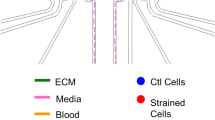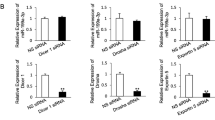Abstract
Introduction
Mechanical force generated from the interstitial fluid flow inside and surrounding tissue has been known to play a significant role in cancer pathophysiology. In this study, we aimed to investigate the role of laminar shear stress (LSS) in modulating the cell cycle of human bladder transitional carcinoma (BFTC-905) cells which are frequently stimulated by not only the interstitial fluid flow, but also the urine flow transported from kidney to bladder in the urinary tract.
Methods
The BFTC-905 cells were subjected to 0–12 dynes cm−2 LSS for 1, 4, 8, or 12 h, respectively, followed by cellular and molecular assays for investigations of cell cycle regulation protein expressions, cell growth rates, and the potential mechanism.
Results
The results showed that the LSS with ≥ 8 dynes cm−2 for ≥ 8 h significantly increased protein expressions of cyclin B1, Wee1, p21, and p-CDK1(Tyr15) (p < 0.05 for each), but conversely decreased protein expressions of cyclin A2, D1, E1, and CDK-1, -2, -4, and -6 (p < 0.05 for each) in the BFTC-905 cells, indicating that a G2/M cell cycle arrest was obtained after shearing stimulation. Furthermore, our data demonstrated that the LSS-induced G2/M arrest and the corresponding changes in cell cycle regulatory protein expressions were modulated by bone morphogenetic protein (BMP) receptor-Smad1/5 signaling pathway.
Conclusions
Our findings provided evidences for the effect of mechanical microenvironment on urothelial cancer pathobiology and generated insights into mechanism of LSS-regulated bladder tumor cell cycle.






Similar content being viewed by others
References
Allard, P., P. Bernard, Y. Fradet, and B. Têtu. The early clinical course of primary Ta and T1 bladder cancer: a proposed prognostic index. Br. J. Urol. 81(5):692–698, 1998.
Antoni, S., J. Ferlay, I. Soerjomataram, A. Znaor, A. Jemal, and F. Bray. Bladder cancer incidence and mortality: a global overview and recent trends. Eur. Urol. 71(1):96–108, 2017.
Bleuming, S. A., X. C. He, L. L. Kodach, J. C. Hardwick, F. A. Koopman, F. J. Ten Kate, S. J. van Deventer, D. W. Hommes, M. P. Peppelenbosch, G. J. Offerhaus, L. Li, and G. R. van den Brink. Bone morphogenetic protein signaling suppresses tumorigenesis at gastric epithelial transition zones in mice. Cancer Res. 67(17):8149–8155, 2007.
Cai, Z., J. Xin, D. M. Pollock, and J. S. Pollock. Shear stress-mediated NO production in inner medullary collecting duct cells. Am. J. Physiol. Renal Physiol. 279(2):F270–F274, 2000.
Chiu, J. J., and S. Chien. Effects of disturbed flow on vascular endothelium: pathophysiological basis and clinical perspectives. Physiol. Rev. 91(1):327–387, 2011.
Cohen, S. M., and L. B. Ellwein. Cell proliferation in carcinogenesis. Science 249(4972):1007–1011, 1990.
Den Haese, G. J., N. Walworth, A. M. Carr, K. L. Gould, and K. L. The. Wee1 protein kinase regulates T14 phosphorylation of fission yeast Cdc2. Mol. Biol. Cell. 6(4):371–385, 1995.
Farber, E. Cell proliferation as a major risk factor for cancer: a concept of doubtful validity. Cancer Res. 55(17):3759–3762, 1995.
Graña, X., and E. P. Reddy. Cell cycle control in mammalian cells: role of cyclins, cyclin dependent kinases (CDKs), growth suppressor genes and cyclin-dependent kinase inhibitors (CKIs). Oncogene 11(2):211–219, 1995.
Hofmann, M., M. Guschel, A. Bernd, J. Bereiter-Hahn, R. Kaufmann, C. Tandi, H. Wiig, and S. Kippenberger. Lowering of tumor interstitial fluid pressure reduces tumor cell proliferation in a xenograft tumor model. Neoplasia 8(2):89–95, 2006.
Ikushima, H., and K. Miyazono. TGFbeta signalling: a complex web in cancer progression. Nat. Rev. Cancer 10(6):415–424, 2010.
Jain, R. K., R. T. Tong, and L. L. Munn. Effect of vascular normalization by antiangiogenic therapy on interstitial hypertension, peritumor edema, and lymphatic metastasis: insights from a mathematical model. Cancer Res. 67(6):2729–2735, 2007.
Jemal, A., F. Bray, M. M. Center, J. Ferlay, E. Ward, and D. Forman. Global cancer statistics. CA Cancer J. Clin. 61(2):69–90, 2011.
Jiang, W. G., A. J. Sanders, M. Katoh, H. Ungefroren, F. Gieseler, M. Prince, et al. Tissue invasion and metastasis: molecular, biological and clinical perspectives. Semin. Cancer Biol. 35(Suppl):S244–S275, 2015.
Kim, B. G., C. Li, W. Qiao, M. Mamura, B. Kasprzak, M. Anver, L. Wolfraim, S. Hong, E. Mushinski, M. Potter, S. J. Kim, X. Y. Fu, C. Deng, and J. J. Letterio. Smad4 signaling in T cells is required for suppression of gastrointestinal cancer. Nature 441(7096):1015–1019, 2006.
Kuo, C. C., H. P. Hsieh, W. Y. Pan, C. P. Chen, J. P. Liou, S. J. Lee, Y. L. Chang, L. T. Chen, C. T. Chen, and J. Y. Chang. BPR0L075, a novel synthetic indole compound with antimitotic activity in human cancer cells, exerts effective antitumoral activity in vivo. Cancer Res. 64(13):4621–4628, 2004.
Lee, H. J., A. Ewere, M. F. Diaz, and P. L. Wenzel. TAZ responds to fluid shear stress to regulate the cell cycle. Cell Cycle 16:1–21, 2017.
Lee, Y. H., C. C. Lee, C. H. Huang, and F. M. Ho. Laminar shear stress promotes nicotine-induced inflammation and hemostatic expression in human endothelial cells. Cell. Mol. Bioeng. 9(3):466–477, 2016.
Manoharan, M. Intravesical therapy for urothelial carcinoma of the bladder. Indian J. Urol. 27(2):252–261, 2011.
Mitra, A. P., D. I. Quinn, T. B. Dorff, E. C. Skinner, A. K. Schuckman, G. Miranda, I. S. Gill, and S. Daneshmand. Factors influencing post-recurrence survival in bladder cancer following radical cystectomy. BJU Int. 109(6):846–854, 2012.
Motoshima, H., B. J. Goldstein, M. Igata, and E. Araki. AMPK and cell proliferation—AMPK as a therapeutic target for atherosclerosis and cancer. J. Physiol. 574(Pt 1):63–71, 2006.
Nerem, R. M. Tissue engineering: the hope, the hype, and the future. Tissue Eng. 12(5):1143–1150, 2006.
Netti, P. A., L. T. Baxter, Y. Boucher, R. Skalak, and R. K. Jain. Time-dependent behavior of interstitial fluid pressure in solid tumors: implications for drug delivery. Cancer Res. 55(22):5451–5458, 1995.
Netti, P. A., L. M. Hamberg, J. W. Babich, D. Kierstead, W. Graham, G. J. Hunter, G. L. Wolf, A. Fischman, Y. Boucher, and R. K. Jain. Enhancement of fluid filtration across tumor vessels: implication for delivery of macromolecules. Proc. Natl Acad. Sci. U.S.A. 96(6):3137–3142, 1999.
Rutkowski, J. M., and M. A. Swartz. A driving force for change: interstitial flow as a morphoregulator. Trends Cell Biol. 17(1):44–50, 2007.
Shin, S. Y., Y. Yong, C. G. Kim, Y. H. Lee, and Y. Lim. Deoxypodophyllotoxin induces G2/M cell cycle arrest and apoptosis in HeLa cells. Cancer Lett. 287(2):231–239, 2010.
Siegel, R. L., K. D. Miller, and A. Jemal. Cancer statistics, 2016. CA Cancer J. Clin. 66(1):7–30, 2016.
Tarbell, J. M., and Z. D. Shi. Effect of the glycocalyx layer on transmission of interstitial flow shear stress to embedded cells. Biomech. Model. Mechanobiol. 12(1):111–121, 2013.
Xiong, N., S. Li, K. Tang, H. Bai, Y. Peng, H. Yang, C. Wu, and Y. Liu. Involvement of caveolin-1 in low shear stress-induced breast cancer cell motility and adhesion: roles of FAK/Src and ROCK/p-MLC pathways. Biochim. Biophys. Acta. 1864(1):12–22, 2017.
Yu, P. B., C. C. Hong, C. Sachidanandan, J. L. Babitt, D. Y. Deng, S. A. Hoyng, H. Y. Lin, K. D. Bloch, and R. T. Peterson. Dorsomorphin inhibits BMP signals required for embryogenesis and iron metabolism. Nat. Chem. Biol. 4(1):33–41, 2008.
Zhou, J., P. L. Lee, C. I. Lee, S. Y. Wei, S. H. Lim, T. E. Lin, S. Chien, and J. J. Chiu. BMP receptor-integrin interaction mediates responses of vascular endothelial Smad1/5 and proliferation to disturbed flow. J. Thromb. Haemost. 11(4):741–755, 2013.
Acknowledgments
This work was financially supported by Ministry of Science and Technology, Taiwan R.O.C. (MOST 106-2221-E-008-060; Y.-H. Lee and MOST 106-2314-B-281-001-MY3; Y.-C. Cheng).
CONFLICT OF INTEREST
Yu-Hsiang Lee, Chia-Wei Lai, and Yu-Che Cheng declare no conflict of interest.
COMPLICANCE WITH ETHICAL STANDARDS
This article does not contain any studies with human participants or animals performed by any of the authors.
Author information
Authors and Affiliations
Corresponding authors
Additional information
Associate Editor Partha Roy oversaw the review of this article.
Rights and permissions
About this article
Cite this article
Lee, YH., Lai, CW. & Cheng, YC. Fluid Shear Stress Induces Cell Cycle Arrest in Human Urinary Bladder Transitional Cell Carcinoma Through Bone Morphogenetic Protein Receptor-Smad1/5 Pathway. Cel. Mol. Bioeng. 11, 185–195 (2018). https://doi.org/10.1007/s12195-018-0523-1
Received:
Accepted:
Published:
Issue Date:
DOI: https://doi.org/10.1007/s12195-018-0523-1




